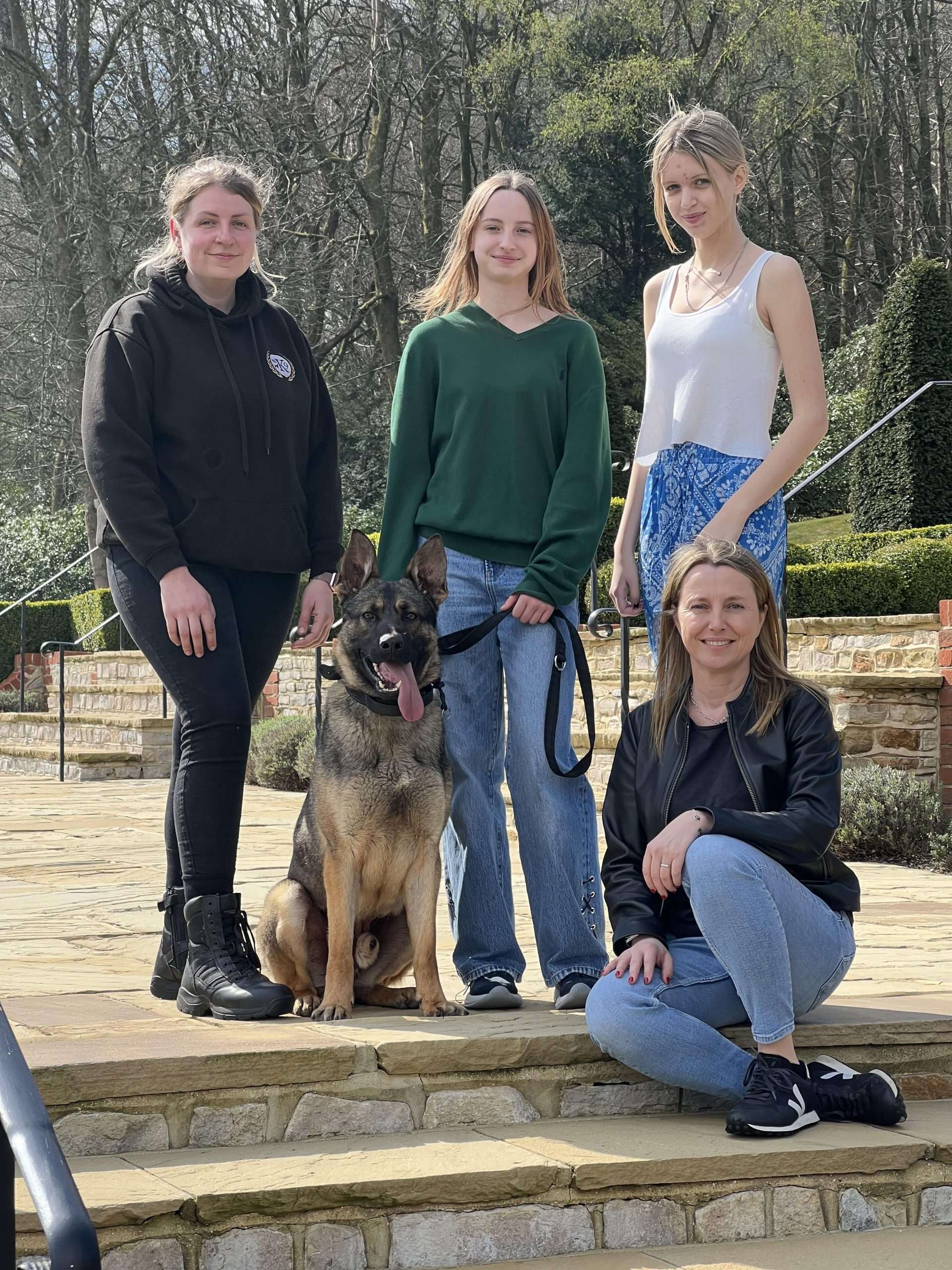Keeping your family safe, comfortable and protected is a task made much easier when you bring a protection dog into your life. These loyal animal companions can improve your peace of mind by adding extra security, protection and love into the home. These highly trained animals are more than just pets or guardians; they are often viewed as a core part of the family.
However, there is an enduring stigma that surrounds protection dogs, with many people falsely believing they pose a risk. In this article, we’ll find out if protection dogs are safe around children and families to help you make an informed decision about getting a protection dog for your home.
What is a Protection Dog?
A good protection dog is specifically trained to guard individuals or property against threats. Unlike aggressive or poorly socialised dogs, protection dogs are trained to be obedient, calm, and alert. They are not attack dogs; rather, they act on command or in situations where their handler is under direct threat.
Breeds commonly used for this role include German Shepherds, Belgian Malinois, Dobermans, and Rottweilers, among others. These dogs are chosen not just for strength and intelligence, but also for their ability to bond closely with families.
The Myth of Aggression
One of the biggest misconceptions about protection dogs is that they are inherently aggressive or dangerous. This belief often stems from media portrayals or confusion between protection dogs and guard dogs. While guard dogs may be trained primarily for territorial defence and are often left to operate independently, protection dogs receive extensive socialisation and obedience training.
Protection dogs are trained to distinguish between normal behaviour and genuine threats. They are not triggered by loud noises, running children, or strangers at the door — unless those strangers pose a real risk. This makes them far more predictable and manageable than untrained dogs with aggressive tendencies. Their training also makes protection dogs quite versatile as they can help with emotional support, day-to-day activities and much more.
Professional Training Makes All the Difference
The key factor in a protection dog’s safety and effectiveness is professional training. Reputable trainers in the UK, like our team at TOTALK9, follow rigorous standards to ensure dogs are responsive in high-pressure situations but also gentle and well-mannered in everyday family life. Training often begins in puppyhood and continues throughout the dog’s early years, focusing on key areas such as:
• Obedience
• Socialisation with adults and children
• Environmental conditioning (noises, busy streets, different surfaces)
• Controlled protection work
Training includes simulated scenarios where the dog must respond to threats while ignoring distractions, including shouting, running, or erratic behaviour from children. By exposing dogs to a wide range of environments and people, trainers ensure that they are calm, stable, and predictable.
Living With a Protection Dog
When properly trained, protection dogs are excellent family members. They are affectionate, loyal, and enjoy being part of daily activities. Many families enjoy a protection dog that quickly becomes a best friend to their children, often taking on a gentle, almost parental role.
Fitting a Protection Dog Into Your Life
Living with a protection dog involves more than just security; it means integrating a highly intelligent and responsive animal into your daily routines. These dogs typically thrive when they have a clear sense of purpose and structure. Families often find that their protection dog enjoys participating in everyday tasks, from school runs to garden playtime and quiet evenings indoors.
Some protection dogs also adapt well to multi-pet households, provided introductions are handled properly. Their training usually includes exposure to other animals, so they are less likely to display territorial or reactive behaviours. Still, early and supervised socialisation is key.
Protection dogs are particularly good at reading emotional cues. Many owners note that their dogs offer comfort during stressful times and appear to intuitively understand when a family member needs reassurance. This emotional intelligence adds another layer to their role as protectors and companions.
The Benefits of Living With a Protection Dog
There are plenty of reasons why people incorporate protection dogs into their family. Some of the main benefits of living with a protection dog include:
• 24/7 security: A constant presence that deters intruders
• Companionship: Dogs form strong bonds with children and adults alike
• Emotional support: Their calming presence can help reduce anxiety and stress
• Structured family interaction: They often inspire families to create routines and engage in more outdoor activities
These dogs can also help teach children about responsibility, empathy, and respect for animals. As with any pet, children should be taught how to interact safely and respectfully with the dog. Establishing household rules, such as not disturbing the dog while it eats or sleeps, fosters mutual respect and a safer, more harmonious environment for everyone. This form of teaching is just one of the many reasons that make protection dogs so useful in a family home environment.
Choosing the Right Protection Dog for Your Family
Not every protection dog is suitable for every family. Reputable UK-based providers like our team at TOTALK9 work closely with prospective owners to match them with a dog that fits their lifestyle, needs, and household dynamics. Factors that we will consider include:
• Size and energy level of the dog
• Age and number of children
• Home environment (house vs. flat, garden access, etc.)
• Experience with dogs
By taking the time to consider your lifestyle and how you can accommodate a protection dog, you can find the right breed for your needs.
Temperament
It’s also essential to think about the breed’s temperament and how it aligns with your family’s activity level. For instance, a high-energy Belgian Malinois may thrive in a household that enjoys outdoor activities, while a more laid-back Rottweiler might be better suited to a quieter home environment.
Making Time for Your Protection Dog
Families should also consider whether they can commit the time and resources required for the dog’s ongoing training, socialisation, and healthcare needs. Protection dogs, while highly trained, still require daily interaction, structured routines, and continued learning to maintain their skills and well-being.
Age
Furthermore, families with very young children may benefit from choosing slightly older, already-trained dogs rather than puppies, which can be more unpredictable and require more intensive training and supervision. Adult dogs with established temperaments and completed training programmes are often easier to integrate into a family setting.
Ultimately, choosing the right protection dog is not just about finding a security solution, it’s about welcoming a new family member. With proper guidance and thoughtful planning, your protection dog will offer security, companionship, and unconditional loyalty for years to come.
Common Breeds and Their Temperaments
Each protection dog breed has unique characteristics that may make them more or less suited to family life. It’s important to consider the temperament of these breeds to make sure they’ll work well in your family environment. Here are a few commonly used breeds and their typical temperaments:
German Shepherd
German Shepherds are one of the most popular choices for protection work due to their versatility and stable temperament. They are generally good with children when properly socialised and trained. Their alertness makes them excellent watchdogs, while their affectionate nature allows them to form deep bonds with family members.
Belgian Malinois
The Belgian Malinois is favoured in military and police roles but also excels as a family protection dog in active households. They require ample mental and physical stimulation to remain well-behaved, making them ideal for families who enjoy outdoor adventures and structured activities. Despite their high drive, Malinois can be very gentle and loyal companions.
Doberman
Dobermans are known for their natural guarding instincts and intelligence. They are often very affectionate with their human families and can be particularly sensitive to the emotional tone of their environment. With proper socialisation, they do well with children and can become devoted protectors and playmates.
Rottweiler
Rottweilers are powerful dogs with a steady temperament when properly raised. They are affectionate with family members and often gentle with children, although early socialisation is key. They thrive on structure and leadership, and with the right guidance, make loving and dependable guardians.
Giant Schnauzer
Giant Schnauzers are a less common but highly effective protection breed. They have a natural suspicion of strangers and a strong bond with their families. These dogs do best in homes that can provide firm, consistent training and plenty of exercise.
Regardless of breed, temperament testing and early training are vital to ensuring safety and compatibility with children. It is always advisable to work with a professional to evaluate whether a specific dog’s personality matches your household’s needs and lifestyle.
Integrating a Protection Dog Into Family Life
Introducing a protection dog into your home should be a gradual and thoughtful process. With the right approach, both your family and your new dog will enjoy a seamless transition to shared family life. Here are some tips for a smooth integration:
• Introduce gradually: Allow the dog to explore its new environment calmly. Provide a designated space where they feel safe and can retreat if overwhelmed. Gradual introductions to each room and family member help build confidence.
• Supervise early interactions: This is especially important between the dog and young children. Initial playtime should be short and structured, with adults present to guide behaviour on both sides. This allows for the establishment of trust and appropriate boundaries.
• Set boundaries: Establish household rules for both the dog and the family. Clear expectations about where the dog is allowed to go, where it eats or sleeps, and how it should be treated help ensure consistency and a sense of order.
• Follow up with training: Continue to work with a professional trainer as needed for ongoing training. Even after the initial transition, refresher sessions and advanced training can enhance the dog’s responsiveness and further tailor its behaviour to your family’s lifestyle.
• Involve the children: Let them participate in feeding, grooming, and training under adult supervision. Teaching children how to communicate with and care for the dog fosters a respectful, nurturing relationship.
• Encourage bonding time: Include the dog in daily activities such as walks, play sessions, and quiet time indoors. Shared experiences strengthen the dog’s connection to each family member.
• Be patient: Every dog adjusts at its own pace. It’s important to remain calm and understanding if the dog seems shy, overly alert, or hesitant in new situations. Positive reinforcement and a predictable routine will ease the transition.
By creating a stable, loving environment and providing clear communication and structure, families can help their protection dog settle in quickly and comfortably. The result is a mutually trusting relationship that enhances both security and quality of life.
Enjoy a Better Home Life With a Protection Dog
Protection dogs, when carefully selected and professionally trained, can be both safe and enriching companions for families. Far from being dangerous, these dogs are often among the most obedient, loyal, and emotionally intelligent animals one can welcome into the home. With the right guidance, a protection dog can offer unparalleled peace of mind without sacrificing the warmth and joy of family life.
If you’re considering a protection dog for your family, be sure to consult a trusted UK-based provider who specialises in family-safe training, like our team at TOTALK9. The right match could offer not just protection, but a lifelong friend for you and your children.

